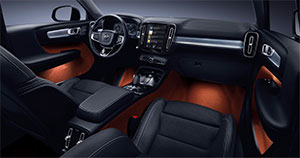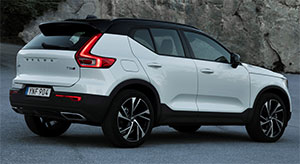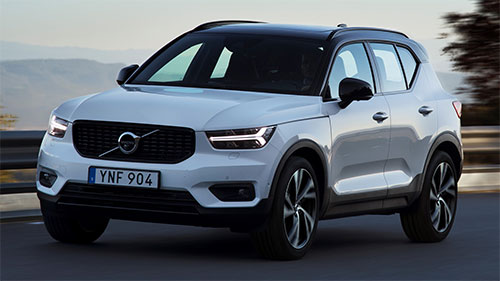2019 Volvo XC40
If you’re Volvo, how do you follow up the fantastic XC90 full-size and XC60 mid-size crossovers? Well, automotive logic would dictate things would continue to trickle down; and indeed they have, with an all-new, compact sized, 2019 Volvo XC40.
It may be Volvo’s smallest crossover yet, but it feels big for the class. And, it is the first modern Volvo not built on the SPA platform, but a new Compact Modular Architecture.
Looking taller and stubbier than its bigger kin, the XC40’s exterior is both bold and cartoonish. We also see traces of Land Rover and Jeep in its luxo-rugged design. There’s plenty to draw the eyes here; from the scooped out grille, deep body cuts, an available contrasting roof, and even a little Swedish flag sticking out from under the clamshell hood. Just don’t tell anyone it’s actually made in Belgium.
 Our tester is a T5, which in current Volvo-speak means the 2.0-liter I4 underneath the hood is turbo-charged. Sums of 248–horsepower and 258 lb.-ft. of torque put it well above class average.
Our tester is a T5, which in current Volvo-speak means the 2.0-liter I4 underneath the hood is turbo-charged. Sums of 248–horsepower and 258 lb.-ft. of torque put it well above class average.
An 8-speed automatic transmission and all-wheel-drive are standard with the T5. Volvo is of course, no stranger to the front-wheel-drive based all-wheel-drive game; having fielded examples for some 20-years, since the 850 Estate, becoming V70XC here in the states.
A naturally-aspirated, 2.0-liter, front-wheel-drive only, XC 40 T4 will arrive here later this year, with a plug-in hybrid and pure EV following that.
The suspension design, and our T5’s ride itself, favors that of its bigger kin; yet needless to say, its diminutive size makes it a breeze to whip around city streets, as well as in and out of traffic. Which you can do quite easily, with incredibly powerful response from the engine.
So, the XC40 squirts off the line quite efficiently as well, capable of hitting 60 in just 6.3-seconds. Power arrives early and stays, shifts click through quickly and smoothly, for a ¼-mile ending in 14.8-seconds at 95 miles-per-hour.
 The XC40 felt nimble and eager through our cone course. Steering is very light, yet we always had a good sense of where our wheels were pointing.
The XC40 felt nimble and eager through our cone course. Steering is very light, yet we always had a good sense of where our wheels were pointing.
There’s laser-like attention to interior details, with a wealth of sensible storage options throughout the cabin. On the flip side, the shortage of physical controls, and over reliance on a big touch screen, didn’t impress us.
When it comes to materials and theme, it’s totally Swedish; with pleasant-looking aluminum on the dash, nicely carpeted door panels, and fit-and-finish commensurate with rival luxury brand.
Size has not impacted the Volvo comfort we’ve come to expect, with a fairly high seating position; again, giving you the impression it’s a larger vehicle.
Rear seat legroom is quite good as well, with adequate headroom for most adults.
In back, there’s 20.7 cubic-ft. of cargo space, maxing out at 47.2 with the rear seats folded; not as roomy as some, but the space is flexible and very nicely finished.
 When it comes to safety systems, if Volvo has it, it’s here; and not just available, but standard.
When it comes to safety systems, if Volvo has it, it’s here; and not just available, but standard.
Government Fuel Economy Ratings are 23-City, 31-Highway, and 26-Combined. We saw a good 27.8 miles-per-gallon with the required Premium. The Energy Impact Score is an average one, at 12.7-barrels of yearly petroleum use, along with CO2 emissions of 5.6-tons.
If all of that wasn’t enough, you can buy one for a more than reasonable $34,195. The T5 with all-wheel-drive, starts at just $36,195. And with this vehicle, Volvo is also launching a new subscription service, that will allow you to get a vehicle including insurance and maintenance for one monthly payment, with no money down. And, much like the millennials they are going after probably already do with their smartphones, you can upgrade your vehicle after as little as one year.
But, what really matters, is that the 2019 Volvo XC40 delivers on all points, with a refined interior and ride quality found nowhere else in the compact segment. Now that Volvo has revamped their entire SUV lineup in just 3-years, it’s hard not seeing the XC40 following in the footsteps of XC90, and 60; which is to say, being another big success.
Specifications
- Engine: 2.0 liter
- Horsepower: 248
- Torque: 258 lb.-ft.
- 0-60 mph: 6.3 seconds
- 1/4 mile: 14.8 seconds @ 95 mph
- EPA: 23 mpg city / 31 mpg highway
- Energy Impact: 12.7 barrels of oil/yr
- CO2 Emissions: 5.6 tons/yr
2024 Toyota Land Cruiser
Toyota’s Go Anywhere Globetrotter Returns To U.S.
Every once in a while, we all need a reset. A time to get back to basics and prioritize the things that really matter. Well, for the Toyota Land Cruiser that time is now. So, let’s find out if that means bigger and better things for Toyota’s iconic off-roader.
The Toyota Land Cruiser’s status among the global off-road community is legendary, and it’s hard to imagine there’s any corner of the earth where a Land Cruiser hasn’t kicked up a little dust or mud. Well, 2024 sees the return of the Land Cruiser to the U.S. market after a 3-year hiatus, getting a major reset for the journey.
The reset comes mostly by no longer being based on the large three-row “300-series” chassis, but a new version of the smaller “200-series,” now known as the J250. As with the latest Tacoma, it uses the Tundra pickup’s full-size steel frame.
While the main Land Cruiser model, which goes by simply Land Cruiser, is packed full of luxury and convenience features, there is also a stripped-down model known as the 1958, honoring the first year the Land Cruiser made landfall here in North America. And it is that 1958 we have here, and we were glad to see it, as it also celebrates the original’s back-to-basics approach as a blank canvas for you to personalize as you tackle more and more adventures.
Not that it’s fully stripped down, as 8-inch touchscreen infotainment, a 7-inch full-color multi-information display, and automatic climate control are still standard. Plus, some seriously durable materials, and great heated cloth front seats that throw off some get serious 1990s Tacoma vibes.
But outside, there’s a definite lack of flashy trim and basic looking 18-inch wheels with Yokohama Geolander all-season tires; plus, big chunky bumpers and tilt-up back glass, which is a rarity that we appreciate. Though there is a little too much plastic in places that are sure to see some abuse if you do any significant off-roading.
It even feels a little rough around the edges, but for us it just adds to the rugged old-school utility vibe in a good way.
We did just that, both here in the Mid-Atlantic as well as in the California desert; and while there are some tech-forward driving aids, the actual hardware is in most cases plenty to get things done. That includes standard full-time dual-range four-wheel-drive, locking center and rear diffs, and 8.7-inches of ground clearance. A front stabilizer bar disconnect is also available to allow for increased articulation.
Who needs a V6 or even a V8 when you’ve got Toyota’s i-FORCE MAX setup at your disposal with 326 horsepower and 465 lb-ft of torque coming from a 2.4-liter turbo-four with an electric motor sandwiched between the engine and its eight-speed automatic transmission. Low speed torque delivery is impressive. It even feels a little rough around the edges, which may be a turn off to some, but for us it just adds to the rugged old-school utility vibe in a good way.
And it certainly feels quicker than an off roader needs to be, with an instant torque dump as soon as we eased on the throttle at our Mason Dixon test track; helping us get to 60 in 8.1 seconds and through the quarter-mile in 16.3 seconds at 86 mph. Considering the Land Cruiser’s terrain conquering mission, it behaved quite well in our handling course; it was plenty responsive to inputs, with less body roll than we expected and plenty of grip from the tires. The steering was light and quick but as expected didn’t provide much feel. Other than significant nosedive, braking performance was exceptional. Only 107-feet to panic stop us from 60 mph.
With the shift to the smaller size, there’s no more third row available, and cargo capacity now comes in at 46.2 cubic-feet with a max of a still healthy 82.1. Now, the best part of the Land Cruiser’s return is the entry price of $57,445. That’s about 30-grand less than what the last Land Cruiser went for back in 2021.
Whether it’s over the top fashion trends, mullets, or zombies; just when you think they’re dead, they come roaring back to life. Of course, we’re much happier to see the resurrection of this 2024 Toyota Land Cruiser than any of those things. Toyota is one brand that still recognizes the value of full-framed rugged rigs and has also acknowledged that sometimes less really is more. The Godfather of Toyota off-roading is back and better than ever.







